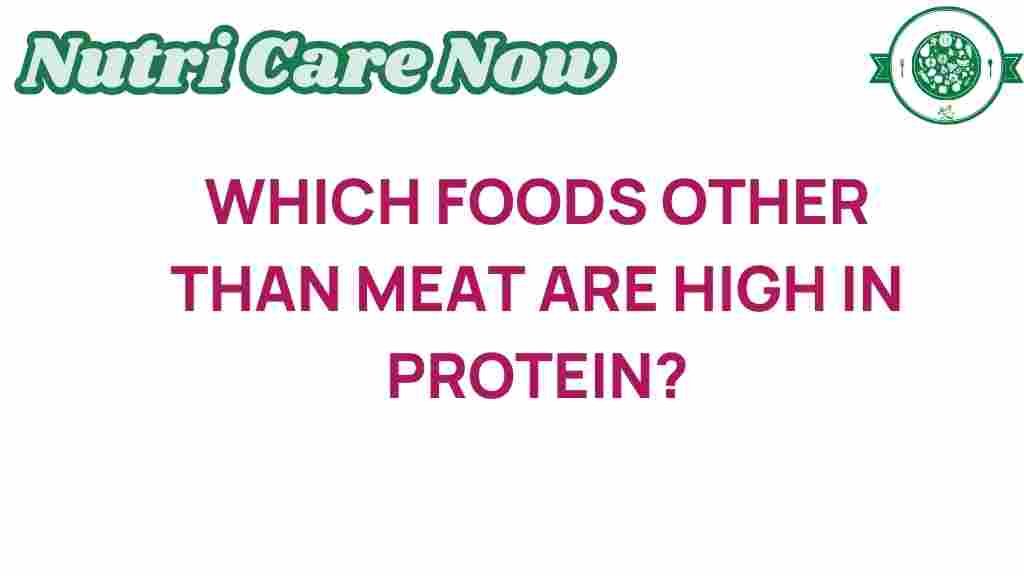Unlocking Protein Power: Surprising Meat Alternatives
In today’s health-conscious world, the quest for nutritious and sustainable protein sources has led many to explore the realm of meat alternatives. With an increasing number of people adopting plant-based protein diets, it’s essential to understand the variety of high-protein foods available that can help you meet your dietary needs. This article will delve into the surprising meat alternatives that pack a protein punch, guiding you on your journey towards healthier eating.
The Rise of Plant-Based Protein
The movement towards plant-based protein has gained significant momentum due to several factors, including health benefits, environmental concerns, and ethical considerations. Many individuals are now seeking vegan options that provide the nutrients they need without relying on animal products.
- Health benefits: A diet rich in high-protein foods can help with muscle building, weight management, and overall wellness.
- Environmental impact: Plant-based diets can reduce your carbon footprint, as livestock farming is resource-intensive.
- Ethical considerations: Many choose plant-based diets to avoid the ethical dilemmas associated with animal farming.
Exploring High-Protein Meat Alternatives
When it comes to finding effective protein sources outside of traditional meats, there are numerous options available that are not only rich in protein but also versatile and delicious. Here are some top contenders:
1. Legumes
Legumes, including beans, lentils, and chickpeas, are excellent sources of plant-based protein. They are not only high in protein but also packed with fiber, making them a great addition to any protein-rich diet.
- Black beans: Approximately 15 grams of protein per cooked cup.
- Lentils: About 18 grams of protein per cooked cup.
- Chickpeas: Roughly 15 grams of protein per cooked cup.
2. Quinoa
Quinoa is a unique grain that is considered a complete protein, meaning it contains all nine essential amino acids. It offers about 8 grams of protein per cooked cup and is also gluten-free.
3. Tofu and Tempeh
Derived from soybeans, both tofu and tempeh are superb meat alternatives that are rich in protein. Tofu has approximately 20 grams of protein per cup, while tempeh contains around 31 grams per cup.
- Tofu: Versatile and can be used in stir-fries, soups, and salads.
- Tempeh: Fermented and has a nutty flavor, making it perfect for sandwiches and bowls.
4. Seitan
Seitan, also known as wheat meat, is made from gluten and is a fantastic source of protein, offering about 25 grams per 3.5-ounce serving. Its chewy texture makes it a popular meat substitute in many dishes.
5. Nuts and Seeds
Nuts and seeds are not only packed with healthy fats but are also great high-protein foods. They can be added to smoothies, salads, or eaten as snacks.
- Almonds: About 6 grams of protein per ounce.
- Chia seeds: Approximately 5 grams of protein per ounce.
- Pumpkin seeds: Roughly 7 grams of protein per ounce.
6. Edamame
Edamame, or young soybeans, are another great source of plant-based protein, containing about 17 grams of protein per cup. They can be enjoyed steamed, in salads, or as a snack.
Step-by-Step Guide to Incorporating Meat Alternatives into Your Diet
Making the transition to a diet rich in meat alternatives can be simple and rewarding. Follow this step-by-step guide to effectively incorporate these high-protein foods into your meals:
Step 1: Educate Yourself
Understanding the nutritional values of various protein sources is crucial. Research different legumes, grains, and meat substitutes to find what appeals to you.
Step 2: Start Small
If you’re new to vegan options, start by replacing one meat-based meal per week with a plant-based option. Gradually increase the frequency as you become more comfortable.
Step 3: Experiment with Recipes
Try out new recipes that feature high-protein foods. From hearty lentil soups to quinoa salads, there are countless dishes to explore. Websites like Minimalist Baker offer a variety of delicious plant-based recipes.
Step 4: Stock Your Pantry
Keep your kitchen stocked with a variety of legumes, grains, nuts, and meat alternatives. Having these ingredients on hand makes it easier to prepare nutritious meals without the need for meat.
Step 5: Stay Balanced
Ensure that you are getting a balanced diet by incorporating a variety of protein sources. Pairing different foods can help you achieve a complete amino acid profile.
Troubleshooting Common Concerns
Transitioning to a protein-rich diet focused on meat alternatives can come with challenges. Here are some common concerns and how to address them:
Concern 1: Lack of Protein
Some people worry that a plant-based diet may not provide enough protein. To combat this, focus on including a variety of high-protein foods in every meal.
Concern 2: Cooking and Preparation
Cooking with meat alternatives may seem daunting at first. Start with simple recipes and gradually expand your cooking skills as you become more comfortable with the ingredients.
Concern 3: Nutritional Deficiencies
Ensure you are getting all essential nutrients by consuming a variety of foods. Consider consulting with a nutritionist to help plan a balanced diet that meets your needs.
Conclusion
Embracing meat alternatives can unlock the power of plant-based protein and lead to healthier eating habits. By exploring diverse protein sources and incorporating them into your meals, you can create a protein-rich diet that satisfies your nutritional needs while being mindful of the environment and ethical considerations.
Whether you are a seasoned vegan or just starting to explore vegan options, there’s a world of delicious and filling alternatives waiting for you. Start your journey today and unlock the protein power of plant-based foods!
This article is in the category Diet and created by NutriCareNow Team
